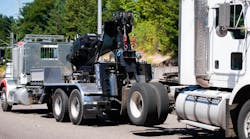As the nightly winter weather forecasts begin to drift into problems related to snow storms, roads closed to trucks and jack-knifed semis, others are looking at severe weather as a golden, if chilly, opportunity. Perhaps topping the list is the idea floated forth in a New York Times piece from Michael Ravnitzky, chief counsel to the chairman of the Postal Regulatory Commission. In it, he suggested that the U.S. Postal Service’s fleet of vehicles could be used as a massive data collection network, including gathering and reporting information about the local weather.
In his opinion piece last December, Ravnitzky started a discussion storm of his own by proposing that the U.S. Postal Service fleet be fitted with electronics to enable the gathering and transmitting of weather data. “The service’s thousands of delivery vehicles have only one purpose now: to transport mail. But what if they were fitted with sensors to collect and transmit information about weather or air pollutants?” he asked. “The trucks would go from being bulky tools of industrial-age communication to being on the cutting edge of 21st-century information-gathering and forecasting.
“The key elements for the project already exist, including tiny, inexpensive G.P.S. receivers and radio uplinks, features found in today’s smartphones,” he argued. “….One company under contract with the National Weather Service is already installing environmental sensors on long-haul commercial buses to enhance weather forecasting.”
Those test buses belonged to Greyhound, and the National Weather Service had such good results from its one-year, 20-bus pilot project that it was awarded a $2.8 million contract to expand the program. You have certainly heard much worse ideas, right?
In July of this year, Mobile Devices reported that Weather Telematics had equipped “1,500 trucks with weather sensors and telematics black boxes from Mobile Devices. These trucks have now collected more than 27 billion weather data points over 15 million miles and generated unparalleled weather data quality,” the article noted. “At the same time, the black boxes continue to provide fleet management services as well as black ice alerts to drivers.”
One feature of the system is an immediate alert to the driver when black ice is detected. “The black ice detection is an inherent part of the system,” the report noted. “The feature is designed to calculate the cross point, which is the difference between dew and frost point. Using a proprietary meteorological algorithm, the black ice detection system combines road surface temperature with data from the other sensors including ambient temperature, humidity and precipitation to determine when moisture changes from liquid form to solid.”
The American Transportation Research Institute (ATRI) has also resolved to take a deeper dive into that wintry truck data pool with the goal of helping keep truckers safe during critical weather events. ATRI joined with the Federal Highway Administration (FHWA) to jointly analyze ATRI’s Freight Performance Measures to identify instances where weather events significantly impacted trucking operations. The data included information from hundreds of thousands of truck GPS units.
In its October newsletter, ATRI announced that it has now “undertaken a research initiative to capture real-time weather data from the National Oceanic & Atmospheric Administration (NOAA) databases.” The moving weather event data, ATRI noted would be geo-fenced onto roadways and truck routes. When trucks enter a fenced “weather buffer zone,” they would receive real-time weather notifications with enough advanced notice to take appropriate action.
According to ATRI, the organization is working “with a major telecommunications provider to engineer a weather information delivery system that would inform drivers of events without creating unnecessary distractions.” ATRI is also working with several motor carriers, states DOTs and NOAA to pilot test the system. Expect to see more information about this come the spring.
Other research projects intended to identify opportunities to mitigate the effects of extreme weather on truck safety have been initiated across the country. At the Mid-America Transportation Center, University of Nebraska in Lincoln, for example, a study was recently conducted on truck crashes tied to the strong winds that bow across the Great Plains.
The study abstract noted that: “High wind speeds have been documented as a perennial cause of truck crashes in Kansas and other Great Plains states. The possibility of reducing such crashes, combined with the installation of dynamic message signs along Interstate 70, created an opportunity for further research. To this end, crash data were obtained from the Kansas Dept. of Transportation’s Accident Records System for all heavy vehicle crashes on I-70 that involved strong winds.”
As it turned out once again, it is an ill wind that blows no good. In this case the “good” was that the wind alone turned out not to be the problem, but rather drivers’ failures to respond to the weather conditions: “From this research, we identified a dilemma zone of wind speeds in which drivers may not be making [appropriate] behavioral changes,” the researchers found. “Furthermore, specific corridors in Kansas are identified as potential areas for the implementation of a warning system. It is recommended that Dynamic Message Signs be tied to weather data stations and/or lighted wind socks be installed on selected overpass bridges.”
It is perhaps ironic that trucking, which often suffers the most from extreme weather, may well be at the forefront of finding better ways to manage through Mother Nature’s worst moments. Cargo, it seems, is not all that trucking delivers.


